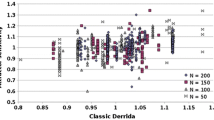Abstract
Boolean networks are a popular class of models for the description of gene-regulatory networks. They model genes as simple binary variables, being either expressed or not expressed. Simulations of Boolean networks can give insights into the dynamics of cellular systems. In particular, stable states and cycles in the networks are thought to correspond to phenotypes. This paper presents approaches to identify attractors in synchronous, asynchronous and probabilistic Boolean networks and gives examples of their usage in the BoolNet R package.
Similar content being viewed by others
References
Albert R, Othmer H (2003) The topology of the regulatory interactions predicts the expression pattern of the segment polarity genes in Drosophila melanogaster. J Theor Biol 223(1): 1–18
Aldana M (2003) Boolean dynamics of networks with scale-free topology. Physica D: Nonlinear Phenomena 185(1): 45–66
Bornholdt S (2005) Systems biology. Less is more in modeling large genetic networks. Science 310(5747): 449–451
Bornholdt S (2008) Boolean network models of cellular regulation: prospects and limitations. J R Soc Interface 5(Suppl. 1): S85–S94
Calzone L, Tournier L, Fourquet S, Thieffry D, Zhivotovsky B, Barillot E, Zinovyev A (2010) Mathematical modelling of cell-fate decision in response to death receptor engagement. PLoS Comput Biol 6(3): e1000702
de Jong H (2002) Modeling and simulation of genetic regulatory systems: a literature review. J Comput Biol 9(1): 67–103
Dojer N, Gambin A, Mizera A, Wilczyński B, Tiuryn J (2006) Applying dynamic Bayesian networks to perturbed gene expression data. BMC Bioinform 7: 249
Fauré A, Naldi A, Chaouiya C, Thieffry D (2006) Dynamical analysis of a generic Boolean model for the control of the mammalian cell cycle. Bioinformatics 22(14): e124–e131
Garg A, Banerjee D, De Micheli G (2008) Implicit methods for probabilistic modeling of gene regulatory networks. In: Proceedings of the 30th annual international IEEE EMBS conference, pp 4621–4627
Garg A, Di Cara A, Xenarios I, Mendoza L, De Micheli G (2008) Synchronous versus asynchronous modeling of gene regulatory networks. Bioinformatics 24(17): 1917–1925
Glass L, Kauffman SA (1973) The logical analysis of continuous, non-linear biochemical networks. J Theor Biol 39(1): 103–129
Goodwin B (1963) Temporal organization in cells: a dynamic theory of cellular control processes. Academic Press, London
Grzegorczyk M, Husmeier D, Rahnenführer J (2010) Modelling non-stationary dynamic gene regulatory processes with the BGM model. Comput Stat 26(2): 199–218
Harvey I, Bossomaier T (1997) Time out of joint: attractors in asynchronous random Boolean networks. In: Proceedings of the forth European conference on artificial life, pp 67–75
Huang S (1999) Gene expression profiling, genetic networks, and cellular states: an integrating concept for tumorigenesis and drug discovery. J Mol Med 77(6): 469–480
Kauffman SA (1969) Metabolic stability and epigensis in randomly constructed genetic nets. J Theor Biol 22(3): 437–467
Kauffman SA (1993) The origins of order: self-organization and selection in evolution. Oxford University Press, Oxford
Kauffman S, Peterson C, Samuelsson B, Troein C (2004) Genetic networks with canalyzing Boolean rules are always stable. PNAS 101(49): 17,102–17,107
Lähdesmäki H, Shmulevich I, Yli-Harja O (2003) On learning gene regulatory networks under the Boolean network model. Mach Learn 52(1–2): 147–167
Li F, Long T, Ouyang Q, Tang C (2004) The yeast cell-cycle network is robustly designed. PNAS 101: 4781–4786
Liang S, Fuhrman S, Somogyi R (1998) REVEAL, a general reverse engineering algorithm for inference of genetic network architectures. Pac Symp Biocomput 3: 18–29
Lynch J (1995) On the threshold of chaos in random Boolean cellular automata. Random Struct Algorithms 6(2–3): 239–260
Müssel C, Hopfensitz M, Kestler HA (2010) BoolNet—an R package for generation, reconstruction and analysis of Boolean networks. Bioinformatics 26(10): 1378–1380
Orlando DA, Lin CY, Bernard A, Wang JY, Socolar JES, Iversen ES, Hartemink AJ, Haase SB (2008) Global control of cell-cycle transcription by coupled CDK and network oscillators. Nature 453(7197): 944–947
Sahin O, Fröhlich H, Löbke C, Korf U, Burmester S, Majety M, Mattern J, Schupp I, Chaouiya C, Thieffry D, Poustka A, Wiemann S, Beissbarth T, Arlt D (2009) Modeling ERBB receptor-regulated G1/S transition to find novel targets for de novo trastuzumab resistance. BMC Syst Biol 3(1): 1
Samuelsson B, Troein C (2003) Superpolynomial growth in the number of attractors in Kauffman networks. Phys Rev Lett 90(9): 098701
Shmulevich I, Dougherty ER, Kim S, Zhang W (2002) Probabilistic Boolean networks: a rule-based uncertainty model for gene-regulatory networks. Bioinformatics 18(2): 261–274
Socolar JE, Kauffman SA (2003) Scaling in ordered and critical random Boolean networks. Phys Rev Lett 90(6): 068–702
Thomas R (1991) Regulatory networks seen as asynchronous automata: a logical description. J Theor Biol 153(1): 1–23
Wawra C, Kühl M, Kestler HA (2007) Extended analyses of the Wnt/β-catenin pathway: Robustness and oscillatory behaviour. FEBS Lett 581(21): 4043–4048
Xiao Y, Dougherty ER (2007) The impact of function perturbations in Boolean networks. Bioinformatics 23(10): 1265–1273
Zhou D, Müssel C, Lausser L, Hopfensitz M, Kühl M, Kestler HA (2009) Boolean networks for modeling and analysis of gene regulation. Ulmer Informatik-Bericht 2009–2010, Ulm University
Author information
Authors and Affiliations
Corresponding author
Additional information
Martin Hopfensitz and Christoph Müssel contributed equally.
Rights and permissions
About this article
Cite this article
Hopfensitz, M., Müssel, C., Maucher, M. et al. Attractors in Boolean networks: a tutorial. Comput Stat 28, 19–36 (2013). https://doi.org/10.1007/s00180-012-0324-2
Received:
Accepted:
Published:
Issue Date:
DOI: https://doi.org/10.1007/s00180-012-0324-2




